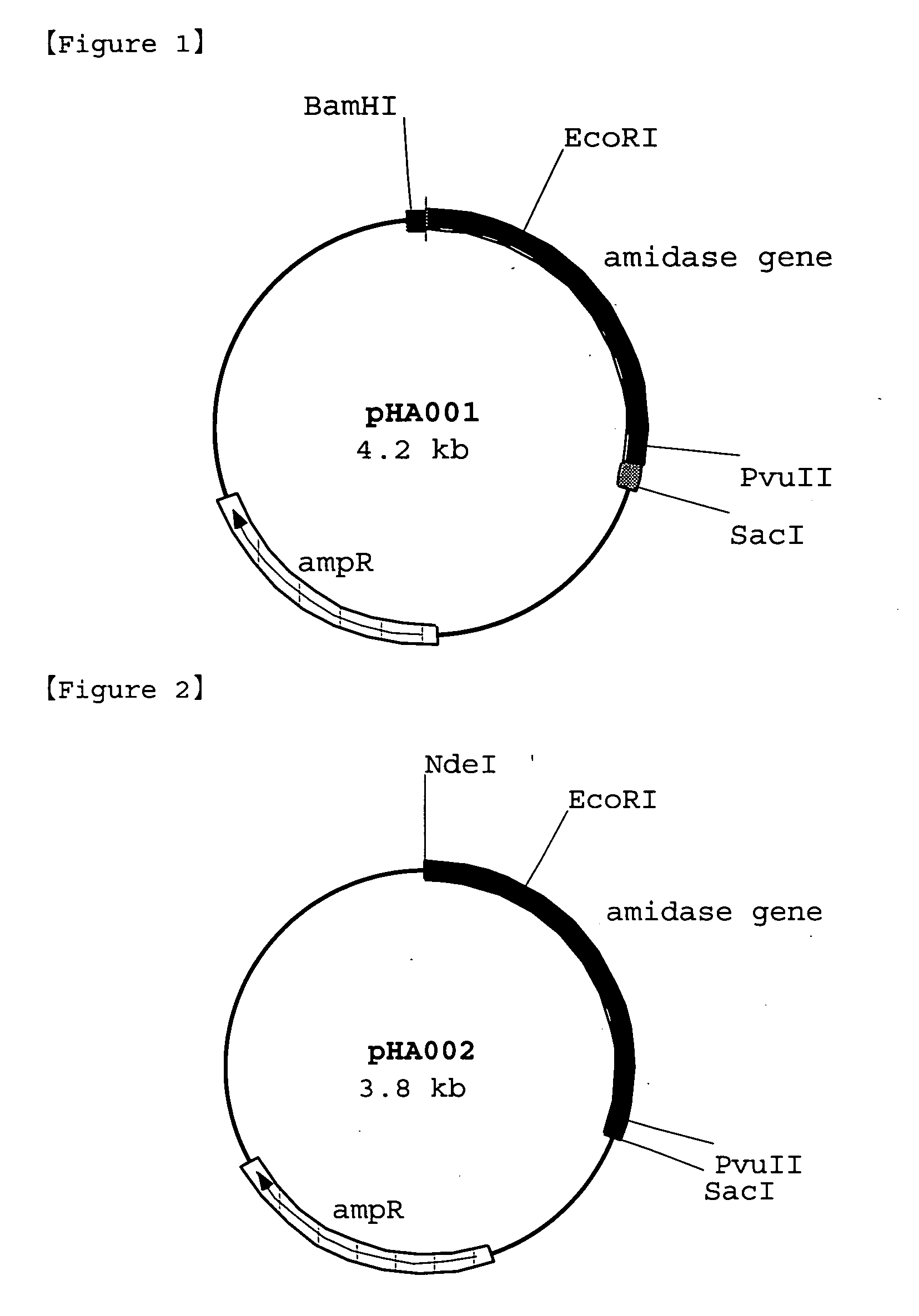Polypeptide having amidase activity and gene thereof
a polypeptide and amidase technology, applied in the field of polypeptides with amidase activity, can solve the problems of inability to say, methods are satisfactory for industrial applications, and the mass production of d--amino acids via fermentation methods has been considered particularly difficult, and achieves the effect of efficient production and efficient production of d-amino acids
- Summary
- Abstract
- Description
- Claims
- Application Information
AI Technical Summary
Benefits of technology
Problems solved by technology
Method used
Image
Examples
example 1
Isolation and Purification of Amidase
[0100]The Arthrobacter sp. KNK1101J (accession No. FERM BP-10192) was inoculated into 6 ml of medium A (produced by mixing 10 g of meat extract, 5 g of yeast extract, 10 g of polypeptone, and 3 g of sodium chloride in deionized water to total 1 L in volume; pH 6.5 before sterilization), which had been sterilized in a test tube. Thereafter, the strain was subjected to an aerobic shaking culture at 30° C. for 24 hours. Thereafter, 2 ml of the culture broth was inoculated into 200 ml of medium A, which had been sterilized in a flask, and it was then subjected to an aerobic shaking culture at 30° C. for 48 hours. After completion of the culture, the cells were harvested by centrifugation, and they were then suspended in a 50 mM Tris-HCl buffer solution (pH 8.0) contained 1 mM dithiothreitol (DTT). The cells were then disrupted with ultrasonic wave, followed by centrifugation. Thereafter, ammonium sulfate was added to the supernatant, resulting in a 4...
example 2
Hydrolysis of Amino Acid Amide with Amidase
[0101]0.1 ml of the purified amidase active fraction obtained in Example 1 was mixed with 0.1 ml of a 0.2 M Tris-HCl buffer solution (pH 8.5) that contained 0.5% of the compound shown in Table 2. The mixture was shaken at 30° C. for 15 hours. After completion of the reaction, solids were eliminated by centrifugation. The yield and optical purity of the generated amino acid were analyzed by high performance liquid chromatography. The results are shown in Table 2.
Conditions for Analysis by High Performance Liquid Chromatography
[Analysis of Yield of Amino Acid]
[0102]Column: COSMOSIL 5C18-AR (4.6 mmφ×250 mm; manufactured by Nacalai Tesque, Inc.)
Eluent: 10 mM potassium phosphate buffer solution (pH 2) / acetonitrile=19 / 1
Flow rate: 0.5 ml / min.
Column temperature: 40° C.
Measurement wavelength: 210 nm
[Analysis of Optical Purity of Amino Acid]
[0103]Column: SUMICHIRAL OA-5000 (4.6 mmφ×150 mm; manufactured by
Sumika Chemical Analysis Service, Ltd.)
[0104]E...
example 3
Hydrolysis of Amino Acid Ester with Purified Amidase
[0105]0.1 ml of the purified amidase active fraction obtained in Example 1 was mixed with 0.1 ml of a 0.2 M 2-(N-morpholino)ethanosulfonic acid-NaOH buffer solution (pH 6.5) that contained a racemic phenylalanine ethyl ester with a concentration of 0.5%. The mixture was shaken at 30° C. for 15 hours. After completion of the reaction, solids were eliminated by centrifugation. The generated amino acid was analyzed by the same method as that described in Example 2. As a result, it was found that D-phenylalanine was obtained in a yield of 29.7 mol % and at an optical purity of 72.8% ee.
PUM
| Property | Measurement | Unit |
|---|---|---|
| pH | aaaaa | aaaaa |
| pH | aaaaa | aaaaa |
| pH | aaaaa | aaaaa |
Abstract
Description
Claims
Application Information
 Login to View More
Login to View More - R&D Engineer
- R&D Manager
- IP Professional
- Industry Leading Data Capabilities
- Powerful AI technology
- Patent DNA Extraction
Browse by: Latest US Patents, China's latest patents, Technical Efficacy Thesaurus, Application Domain, Technology Topic, Popular Technical Reports.
© 2024 PatSnap. All rights reserved.Legal|Privacy policy|Modern Slavery Act Transparency Statement|Sitemap|About US| Contact US: help@patsnap.com








